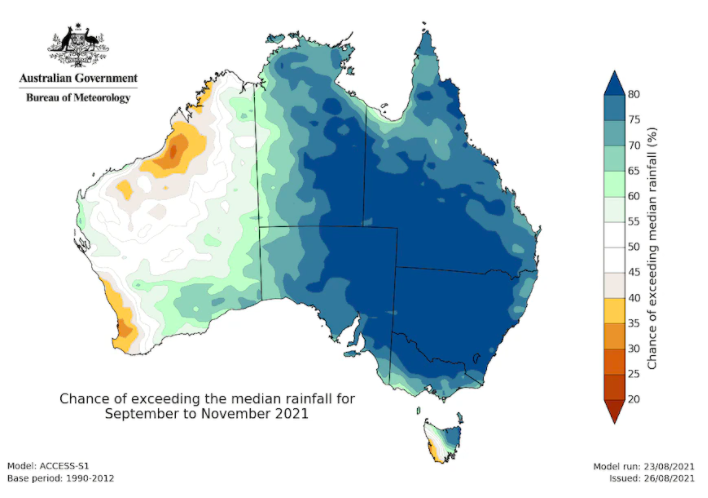Nationwide:
Changing climate factors as well as the global pandemic continue to contribute to volatility across many parts of Australia. While last year we saw five year lows across many states due to the covid-19 shift of demand, this was also assisted by a cooler summer in many parts of the country at levels unseen in the last 20 years.
As vaccination rollouts influence the likelihood of statewide lockdowns easing, we can expect to see an increase in demand as businesses reopen and remain open for longer, potentially impacting pricing in coming months.
Energy retailers are offering to turn residential solar and battery systems into Virtual Power Plants or VPPs. It is a way that you can generate more value from your solar when you have a battery by selling your excess power back to energy retailers when power prices are high. Enquire now about our residential solar and battery package. Call us for an assessment.
With a warm but damp Spring anticipated for many parts of the eastern coast, and above average night time temperatures for the tropical North, meteorologists continue to monitor what we can expect this summer, and how this may change demand, capacity and the cost of energy through Summer 21/22

QLD: As summer is on its way and industry is slowly returning to pre-covid times, Queensland has continued to be troubled by the knock-on effects of the Callide Power Station explosion. Due to difficulties with replacement parts, it is unlikely for this station to be fully operational until the end of next year, leaving some question marks around the capacity for demand as summer temperatures spike.
Plans have been revealed for the ambitious Moah Creek Renewable Energy Project, the first part of what developers say could be a 2 gigawatt renewable energy hub dubbed the Central Queensland Power Project.
The Moah Creek component would combine 400MW of wind, 200MW of solar and a 300MW big battery. It is in its early stages and a first community meeting is scheduled this month.
“We envisage (the project) will facilitate the transition of Central Queensland’s power supply towards firmed renewable energy and in doing so to secure the future for heavy industry in the region,” the developers Renewable energy developers RES and Energy Estate said in an email.
VIC: Since the latest lockdown, the rise in power prices has plateaued after reaching its lowest point in February. This is an ideal window for energy procurement, anticipated to close quickly as we return to normal levels of activity and energy demand which has great impact on the price of energy.
Victoria’s first wholly aboriginal owned and operated solar farm has received one of five grants supporting community-led renewable energy generation across the Gippsland and Latrobe Valley region, empowering the local Aboriginal community to achieve self-determinatcion by developing their own renewable energy generation. Learn more about it here.
NSW: Wholesale rates in NSW are continuing to rise at a steady pace. Recent electricity tenders are still resulting in savings for customers in most cases. However, the savings are diminishing, as major industries anticipate reopening and returning demand to the grid, making it an ideal time for energy procurement as well as solar feasibility assessments for businesses.
The planned closure of Liddel’s power station is now only 12 months away, again bringing into question the stability of demand as supply decreases. As we have seen previously with the Hazelwood closure and discussions around the Yallourn power plant changes, these anticipated movements cause ripples of volatility throughout the market, and pose a potential risk as energy costs climb on regardless.
TAS: As the energy market remains fairly low and stable in our most southern state, Tasmanian businesses are presented with the opportunity to optimise their energy bills and lock in potential savings for the coming years.
The state government has also announced plans for a new government unit dedicated to climate change and renewable energy projects as part of the budget.
Premier Peter Gutwein said the main task would be to capture the opportunities, jobs and investment that Tasmania's unique renewable energy and emissions position provides.
"Renewables, Climate and Future Industries Tasmania will provide the necessary advice to ensure that investment in renewable energy, hydrogen, Marinus link and Battery of the Nation projects, along with climate change adaptation and mitigation, are strategically considered," Mr Gutwein said.